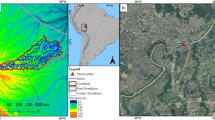Abstract
Over the course of hydrological research projects often a large number of heterogeneous data sets are acquired from sources as diverse as boreholes, gauging stations or satellite imagery. This data then need to be integrated into models for the simulation of hydrological processes. We propose a framework for exploration of geoscientific data and visually guided preparation of such models. Data sets from a large number of sources can be imported, combined and validated to avoid potential problems due to artefacts or inconsistencies between data sets in a subsequent simulation. Boundary conditions and domain discretisations for surface and subsurface models can be created and tested regarding criteria indicating possible numerical instabilities. All data sets including simulation results can be integrated into a user-controlled 3D scene and aspects of the data can be enhanced using a number of established visualisation techniques including thresholding and user-defined transfer functions. We present the application of this framework for the preparation of a model for simulation of groundwater flow in a river catchment in southwest Germany investigated in the scope of the WESS project.






Similar content being viewed by others
References
Alcaraz S, Lane R et al (2011) 3d geological modelling using new Leapfrog Geothermal software. In: Proceedings of 36th Workshop on Geothermal Reservoir Engineering, Stanford University, USA
Brauchler R, Cheng JT, Dietrich P, Everett M, Johnson B, Liedl R, Sauter M (2007) An inversion strategy for hydraulic tomography: Coupling travel time and amplitude inversion. J Hydrol 345(3-4): 184–198
Brunner P, Simmons CT (2012) HydroGeoSphere: A Fully Integrated, Physically Based Hydrological Model. Ground Water 50(2):170–176
Cheng WC, Putti M, Kendall DR, Yeh WWG (2011) A real-time groundwater management model using data assimilation. Water Resour Res 47(W06528)
Engelhardt I, Rausch R et al (2012) Impact of shifts in climate during the Mid- and Late Holocene on groundwater resources on the Arabian Peninsula. Environ Earth Sci (submitted, this issue)
Geuzaine C., Remacle JF (2009) Gmsh: a three-dimensional finite element mesh generator with built-in pre- and post-processing facilities. Int J Numer Meth Eng 79(11):1309–1331
Gräbe A, Rödinger T et al (2012) Numerical analysis of the groundwater regime in the western Dead Sea Escarpment, Israel + West Bank. Environ Earth Sci. doi:10.1007/s12665-012-1795-8
Grathwohl P et al (2012) Catchments as reactors: a comprehensive approach for water fluxes and solute turn-over. Environ Earth Sci (submitted, this issue)
Hötzl H, Möller P, Rosenthal E (2009) The water of the Jordan Valley—scarcity and deterioration of groundwater and its impact on the regional development. Springer Verlag, Berlin
Jones RR, McCaffrey KJW et al (2009) Integration of regional to outcrop digital data: 3d visualization of multi-scale geological models. Comput Geosci 35(1):4–18
Kalbacher T, Mettier R et al (2007) Geometric modelling and object-oriented software concepts applied to a heterogeneous fractured network from the grimsel rock laboratory. Comput Geosci 11(1):9–26
Knupp PM (2000) Achieving finite element mesh quality via optimization of the Jacobian matrix norm and associated quantities. Part I–a framework for surface mesh optimization. Int J Numer Meth Eng 48:401–420
Kolditz O, Bauer S et al (2012) OpenGeoSys: an open source initiative for numerical simulation of thermo-hydro-mechanical/chemical (THM/C) processes in porous media. Environ Earth Sci 67(2):589–599
Kolditz O, Diersch HJ (1993) Quasi-steady-state strategy for numerical simulation of geothermal circulation in hot dry rock fractures. Int J Non Lin Mech 28(4):467–481
Luo J, Diersch HJ, Monninkhoff B (2012) 3D Modeling of saline groundwater flow and transport in a flooded salt mine in Stassfurt, Germany. Mine Water Environ 31(2):104–111
Maxwell RM, Lundquist JK, Mirocha JD, Smith SG, Woodward CS, Tompson AFB (2011) Development of a coupled groundwater-atmosphere model. Mon Weather Rev 139(1):96–116
Rink K, Fischer T, Kolditz O (2011) Data visualisation and validation for hydrological models. In: Proceedings of international conference on computer graphics, visualization, computer vision and image processing, pp 169–176. ISBN:978-989-8533-00-5
Rink K, Kalbacher T, Kolditz O (2012) Visual data exploration for hydrological analysis. Environ Earth Sci 65(5):1395–1403
Schroeder W, Martin K, Lorensen B (2006) Visualization Toolkit: an object-oriented approach to 3D graphics, 4th edn. Kitware, Inc., USA
Selle B, Rink K et al (2012) Recharge and discharge controls on groundwater travel times and flow paths to production wells for the Ammer catchment in SW Germany. Environ Earth Sci (submitted, this issue)
Shewchuk JR (2002) What is a good linear finite element? Interpolation, conditioning, anisotropy, and quality measures. Tech rep, Department of Electrical Engineering and Computer Science, University of Berkeley, USA
Si H (2010) Constrained Delaunay tetrahedral mesh generation and refinement. Finite Elem Anal Des 46(1):33–46
Stein ML (1999) Statistical interpolation of spatial data: some theory for kriging. Springer, New York
Sun F, Shao H, et al (2012) Groundwater deterioration in Nankou—a suburban area of Beijing: data assessment and remediation scenarios. Environ Earth Sci. doi:10.1007/s12665-012-1600-8
Taron J, Elsworth D (2009) Thermal-hydrologic-mechanical-chemical processes in the evolution of engineered geothermal reservoirs. Int J Rock Mech Min Sci 46(5): 855–864
Uhlenküken C, Schmidt B, Streit U (2000) Visual exploration of high-dimensional spatial data: requirements and deficits. Comput Geosci 26(1):77–85
Xie M, Agus SS, Schanz T, Kolditz O (2004) An upscaling method and a numerical analysis of swelling/shrinking processes in a compacted bentonite/sand mixture. Int J Numer Anal Meth Geomech 28(15):1479–1502
Zehner B (2010) Mixing Virtual reality and 2D visualization—using virtual environments as visual 3D information systems for discussion of data from geo- and environmental sciences. In: Proceedings of international conference on computer graphics and applications, pp 364–369
Acknowledgements
WESS is supported by a grant from the Ministry of Science, Research and Arts of Baden-Württemberg (AZ Zu 33-721.3-2) and the Helmholtz Center for Environmental Research, Leipzig (UFZ).
Author information
Authors and Affiliations
Corresponding author
Rights and permissions
About this article
Cite this article
Rink, K., Fischer, T., Selle, B. et al. A data exploration framework for validation and setup of hydrological models. Environ Earth Sci 69, 469–477 (2013). https://doi.org/10.1007/s12665-012-2030-3
Received:
Accepted:
Published:
Issue Date:
DOI: https://doi.org/10.1007/s12665-012-2030-3




